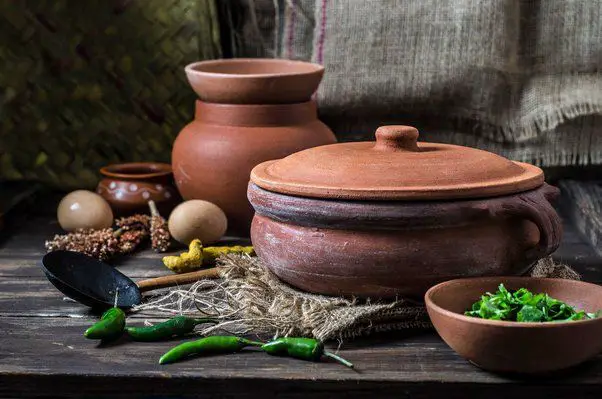What Type Of Clay Is Best For Cooking?
Clay cookware has been used for thousands of years across many cultures for baking, cooking, and food storage. Cooking with clay pots provides many benefits over modern metal pots and pans. Clay is a natural material that provides even heating, heat retention, and can make food more flavorful. The porous nature of clay allows steam to escape from the clay walls, keeping food moist and tender. Unglazed terra cotta clay pots in particular are praised for producing aromatic, robust flavors. Clay pots slowly bring liquids to a simmer or boil, providing gentle cooking. Given proper care and maintenance, clay pots can last for generations.
Types of Clay
There are several different types of clay that are commonly used for cooking, including:
Terracotta Clay
Terracotta clay is an unglazed, porous clay that is fired at low temperatures. It has an earthy red-orange color and is a popular option for tagines, bean pots, and baking dishes. Terracotta maintains even heat distribution and helps food cook slowly and evenly. However, it can absorb moisture and odors, so care should be taken to properly season and clean terracotta cookware (Zishta, 2023).
Earthenware Clay
Earthenware is a natural clay that is fired at lower temperatures than stoneware or porcelain. It is opaque, porous, and easily scratched. Earthenware comes in a variety of colors and glazes. It offers even heating but is prone to cracking or chipping if subjected to thermal shocks. Earthenware should not be used over very high heat.
Stoneware Clay
Stoneware clay is fired at high temperatures, making it nonporous, durable, and able to withstand repeated use. Stoneware comes in natural clay colors or with colored glazes added. It provides even heat distribution and heat retention and is suitable for cooking, baking, and serving. Many tagines, casserole dishes, and pie plates are made of stoneware.
Porcelain Clay
Porcelain clay is fired at the highest temperatures, making it vitrified, nonporous, and resistant to staining. It is smooth, white, and translucent. Porcelain is durable, holds heat well, and provides even cooking. However, it can crack under sudden temperature changes. Porcelain cookware like tandoor ovens, ramekins, and pie dishes have a delicate, attractive appearance.
Terracotta Clay
Terracotta clay is made from natural red clay that is fired at a high temperature. It has an earthy red-orange color and a porous texture that allows steam and moisture to escape during cooking (Source). The porosity means that terracotta clay pots need to be seasoned before first use. Seasoning fills the pores in the clay so food doesn’t absorb tastes from the clay material. To season, coat the inside of the pot by rubbing oil over the surface and heating it in a warm oven for 30 minutes. Let it cool completely before using for cooking. Terracotta has good heat retention properties and even heat distribution making it useful for stews, braises, rice dishes and more.

Earthenware Clay
Earthenware clay is fired at lower temperatures, typically between 1,828°F (998°C) and 1,945°F (1,063°C) (https://potterycrafters.com/what-is-potters-clay-made-of-pottery-clay-ingredients-explained/). This makes earthenware more fragile and delicate compared to stoneware and porcelain clays. Earthenware clay requires glazing to be watertight. The lower firing temperature allows earthenware clays to be glazed with a wider range of colors and effects. Glazes are essential for earthenware to make it functional for cooking or holding liquids.
Earthenware clay has an open, porous body which absorbs water. Without a glaze, earthenware is not suitable for cooking use as it would absorb moisture, flavors, and bacteria. The absorbency also means earthenware is less durable. Glazing creates a non-porous surface better suited for cooking, though it remains more delicate than higher-fired stoneware and porcelain.
Stoneware Clay
Stoneware clay is one of the most popular clays for cooking and baking purposes. It is denser and less porous than earthenware, making it very durable and resistant to chipping according to New Clay Pottery. Stoneware has excellent thermal properties and can be used for oven baking, broiling, and braising as it withstands high temperatures.
The higher firing temperatures of stoneware – around 2200°F to 2400°F – vitrifies the clay, resulting in a non-porous material that will not absorb liquids according to the Digital Fire Ceramic Glossary. This makes stoneware ideal for items that will hold liquids, like mugs or cooking pots.
Stoneware is typically stronger and more durable than earthenware clays that fire at lower temperatures. The vitrified nature of stoneware makes it very resistant to chips and cracks, even with frequent use. Its durability and range of firing temperatures make it a versatile choice for cooking and baking applications.
Porcelain Clay
Porcelain clay is made from kaolin clay that has been fired at very high temperatures, typically between 2,200°F and 2,500°F (see https://digitalfire.com/glossary/porcelain). This results in a nonporous, vitrified ceramic that is extremely hard and glass-like. Porcelain is highly resistant to chipping, staining, and wear. It can withstand repeated and extreme changes in temperature, which makes it ideal for baking and cooking. The composition and high firing temperature allows porcelain to be molded very thinly. It has a smooth, refined appearance and feel. Porcelain clay contains no iron, firing to a bright white color.
The nonporous nature of porcelain makes it impermeable to water and resistant to staining from food (see https://potterycrafters.com/stoneware-clay-vs-porcelain-clay/). Porcelain clay is an excellent choice for dishes, plates, mugs, bowls, and other serving pieces intended for food and drink. It can withstand the high heats of the oven, stovetop, microwave, and dishwasher without cracking. Porcelain’s durability, stain resistance, and thin shape make it a top choice for serious home cooks and bakers.
Best Uses for Each Type
Different types of clay are best suited for different culinary uses based on their properties. Here are some of the best uses for each clay type:
Terracotta
Terracotta clay is ideal for:
- Everyday dishes like serving bowls, plates, cups, and cookware. The unglazed surface allows foods to breathe.
- Baking bread and pizza. The clay promotes even browning and a crisp crust.
- Roasting meat and vegetables. Terracotta retains and distributes heat well for roasting.
Earthenware
Earthenware clay works well for:
- Bakeware like pie dishes, tart pans, and ramekins. The glazed surface prevents sticking.
- Slow-cooked stews and braises in a Dutch oven. The clay disperses heat gently and evenly.
- Serving soups and chili. Earthenware bowls retain heat to keep food warm at the table.
Source: https://www.epicurious.com/shopping/a-guide-to-clay-cooking-pots
Factors in Choosing Clay
When selecting the right clay for cooking, there are a few key factors to consider:
Porosity
The porosity of the clay affects how well it retains heat and moisture. More porous clays like terracotta tend to cook food more evenly. Less porous clays like porcelain hold less moisture so food may cook faster (https://m.facebook.com/Zishta/videos/3473952009500277/).
Thermal Properties
Different clays have different thermal shock resistance. Stoneware clay can withstand rapid temperature changes better than earthenware. Porcelain clay has a high firing temperature so it maintains heat very efficiently.
Strength
The strength and durability varies among clay types. Porcelain is the strongest while earthenware is more delicate. Stoneware falls in between. Stronger clays hold up better to daily cooking and cleaning.
Care and Maintenance
Properly caring for and maintaining clay cookware is important for getting the best results and longevity. Here are some key tips:
Seasoning – Before first use, season the clay cookware by coating the inside with a thin layer of oil and letting it bake in a 350°F oven for 30 minutes. This helps seal the pores. Over time and through use, the clay will become naturally seasoned.
Avoid Soaking – Do not let clay pots soak or stand in water for long periods, as this can weaken the material over time. Rinse promptly after use.
Gentle Cleaning – Use a soft sponge or cloth to gently clean clay cookware. Avoid abrasive scouring powders or metal scrubbers. If needed, you can use a plastic scrubber to remove stubborn residue.
Storage – Allow clay pots to fully dry after cleaning. Store them in a dry place. Apply a light coating of oil occasionally if not using regularly.
With proper care and maintenance, clay cookware can last for many years, continuing to improve in performance over time.
Conclusion
In summary, the type of clay that is best for cooking depends primarily on the intended use and cooking temperature. Porcelain and stoneware clays stand up best to high heat, making them ideal for ovenware and stovetop cooking. Their low porosity also makes them resistant to stains. Earthenware clays are better suited for low or moderate heat cooking, like casserole dishes, and provide attractive glazed finishes. Terracotta clay is traditional for items like tagines and clay pot cooking, and imparts an earthy flavor. Good moisture retention and thermal properties also make these clays effective cooking vessels.
When choosing clay cookware, consider the temperature of the intended cooking use, whether a decorative or natural finish is desired, the importance of stain resistance, and whether an unglazed or more porous vessel is suitable. Test new clay wares at lower temperatures first and follow manufacturer recommendations. With proper care and use relative to the type of clay, quality cookware can provide many years of exemplary cooking performance.


